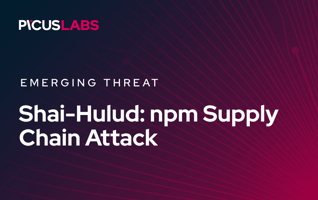Going Beyond Assumptions: Risk Quantification with Security Validation
Cybersecurity is no longer just a technical concern - it’s a core business risk that demands transparency, accountability and financial clarity. And, while business leaders need quantifyable insights into the potential impact of cyber threats, many are left trying to make the most of risk quantification models that just fall short.
They rely heavily on assumptions and self-reported data, often asking security teams to complete questionnaires or submit asset metadata. The outcome is often a polished number, but one that lacks transparency, context, or validation. These black-box calculations offer little confidence when the stakes are high.
What’s needed is a continuous, evidence-based view of risk that delivers the clarity that business leaders need to prioritize, act, and invest with confidence.
Why Traditional Risk Quantification Falls Short
Assumption-based models are commonly used in the cyber risk quantification space. These tools attempt to estimate risk using self-assessments, static maturity models, and generic threat profiles, often detached from how real-world attacks unfold. They rely on organizations to describe their environments, rate control effectiveness, and assign implementation levels through surveys or templates. From these subjective inputs, the tools generate probability and impact scores without ever testing whether controls would actually detect or prevent an attack. The result is a risk model that may appear structured but offers little correlation to the actual conditions and exposures within the environment.
The problem isn’t just inaccuracy; it also creates an illusion of precision. Numerical scores built on inputs alone cannot capture the complexity of modern environments, the speed at which attackers evolve, or the variability of control performance across business units. These models offer limited visibility, no way to validate assumptions over time, and little operational value.
Validation changes the equation entirely. By continuously simulating adversary techniques through Breach and Attack Simulation (BAS), organizations gain direct visibility into how their defenses perform under real attack conditions. This approach replaces assumptions with observable outcomes, providing a reliable measure of control effectiveness across systems, environments, and attack surfaces. When mapped to the MITRE ATT&CK framework, these results offer a structured, transparent, and repeatable method for assessing risk, grounded in what actually happens, not in what’s expected to happen.
Instead of relying on questionnaires or inferred maturity levels, validation provides direct evidence of what threats can bypass existing defenses, where detection gaps exist, and which attack techniques remain effective. These results are mapped to the MITRE ATT&CK framework, offering a standardized and transparent structure for understanding risk at the technique level.
With this level of proof, risk quantification becomes more than a theoretical model. It becomes a process grounded in observation, repeatable over time, and capable of adapting to both environmental change and evolving adversary behavior. Validation transforms risk scores from abstract estimations into decision-ready metrics that reflect the true state of your security posture.
Picus Risk Quantification Module
Picus approaches cyber risk quantification with a validation-first philosophy, combining its breach simulation capabilities with ThreatConnect’s Risk Quantifier to deliver comprehensive, real-world calculations. The Risk Quantification Module is purpose-built to move beyond assumption-based scoring, replacing it with measurable outcomes derived from continuous attack simulations. At its core, it connects security performance to business impact, not through static models, but through validated data that reflects how controls actually perform under adversary techniques.
It begins with Breach and Attack Simulation (BAS), which continuously tests your environment against a broad set of adversarial techniques. Each simulation is mapped to the MITRE ATT&CK framework, providing precise and traceable insights into which techniques succeed, which controls respond, and where exposures persist.
These validated findings are then integrated with ThreatConnect’s Risk Quantifier, which calculates risk using a wide range of factors, including threat actor activity, asset value, exploitability, and control effectiveness. What makes this integration powerful is the use of actual validation data. Picus confirms whether a threat technique can bypass your controls, enabling far more accurate financial risk estimates than assumption-based models can offer.
To make risk more operationally meaningful, the module supports business scoping, allowing teams to segment their environment by department, region, service, or technology. This helps organizations assess risk at a more granular level, prioritize based on operational relevance, and align remediation strategies with business impact.
Picus also quantifies exposure to specific threat actors by correlating simulation data with threat intelligence. This enables organizations to understand not only what techniques work, but which adversaries are most likely to exploit them along with the potential financial consequences.
These capabilities come together in the Business Risk Dashboard, where validation-backed data is visualized in real time. Teams can view Financial Impact Overviews that reflect the true cost of a breach based on validated exposures, business context, and sector benchmarks. They can evaluate Security Control Visibility to determine how well tools are performing under attack, and they can analyze risk across defined Business Scopes to focus attention where it matters most.
Additionally, a dedicated Top Threat Actors section reveals the financial risk posed by the most active adversaries targeting your industry, helping stakeholders make informed decisions grounded in evidence, not assumptions.
With the Picus Risk Quantification Module and Business Risk Dashboard, security teams gain a defensible, transparent, and operationally useful view of cyber risk built not on what might happen, but on what has been proven possible.
Why Validation Must Be the Foundation of Risk Decisions
Cybersecurity has long relied on best guesses and theoretical frameworks. However, effective risk management requires observable outcomes, measurable control performance, and financial modeling rooted in a real-world context. Validation-backed risk quantification delivers exactly that. It’s not only more accurate, but also far more actionable.
Picus and ThreatConnect bring this capability together by combining continuous adversary simulation with dynamic business impact modeling, they enable organizations to quantify risk based on evidence, not speculation. Our unique approach brings greater clarity, supports faster and more focused remediation, and fosters stronger alignment between technical teams and business leadership.








